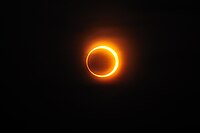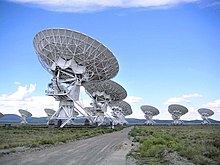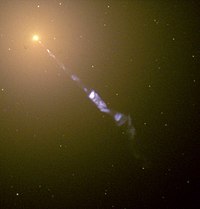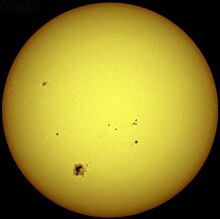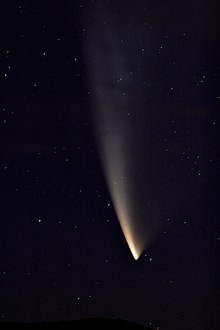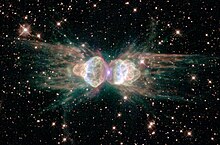Astronomy
Astronomy (from the Greek άστρον [ástron] 'star' and νομία [nomy] ' norms', 'laws of the stars') is the natural science that studies the celestial bodies of the universe, including stars, planets, their natural satellites, asteroids, comets and meteoroids, matter interstellar, nebulae, dark matter, galaxies and so on; Therefore, it also studies the astronomical phenomena linked to them, such as supernovae, quasars, pulsars, cosmic background radiation, black holes, among others, as well as the natural laws that govern them. Astronomy, likewise, encompasses the study of the origin, development, and final destiny of the Universe as a whole through cosmology, and is related to physics through astrophysics, chemistry to astrochemistry, and biology to astrobiology.
Their record and the investigation of their origin comes from the information that comes from them through electromagnetic radiation or any other means. Most of the information used by astronomers is collected by remote sensing, although it has been possible to reproduce, in some cases, in laboratories, the execution of celestial phenomena, such as, for example, the molecular chemistry of the interstellar medium. It is one of the few sciences in which amateurs can still play an active role, especially about the discovery and monitoring of phenomena such as light curves of variable stars, discovery of asteroids and comets, etc...
Astronomy has been linked to the human being since ancient times and all civilizations have had contact with this science. Characters such as Aristotle, Thales of Miletus, Anaxagoras, Aristarchus of Samos, Hipparchus of Nicaea, Claudio Ptolemy, Hypatia of Alexandria, Nicolás Copernicus, Tycho Brahe, Johannes Kepler, Galileo Galilei, Christiaan Huygens or Edmund Halley have been some of its cultivators. The scientific methodology of this field began to develop in the mid-XVII century. A key factor was the introduction of the telescope by Galileo Galilei, which made it possible to examine the night sky in more detail. The mathematical treatment of astronomy began with the development of celestial mechanics and the laws of gravitation by Isaac Newton, although it had already been set in motion by the earlier work of astronomers such as Johannes Kepler. By the 19th century, astronomy had developed as a formal science, with the introduction of instruments such as the spectroscope and the photography, which allowed the continuous improvement of telescopes and the creation of professional observatories.
Etymology
The word astronomy comes from the Latin astrŏnŏmĭa /astronomy/ and this from Greek ἀστρονομία /astronomy/. It is composed of the words άστρον /ástron/ 'stars', which in turn comes from ἀστῆρ /astḗr/ & #39;star', 'constellation', and νόμος /nómos/ 'rule', 'norm', 'order'.
The lexeme ἀστῆρ / astḗr/ is linked to Proto-Indo-European roots *ster~/*~stel (noun) 'star' present in the traditional word «star» that comes from the Latin «stella». He can also be seen in: astrology, asteroid, asterisk, disaster, disastrous and many others.
The lexeme ~νομία /nomíā/ 'regulation', 'legislation'; comes from νέμω /némoo/ 'count', 'assign', 'take&# 39;, 'distribute', 'distribute according to the rules' and is linked to the Indo-European root *nem~ 'to count', 'to allocate', 'to take', to distribute'; plus the lexeme ~ία /~ íā/ 'action', 'quality'. It can be seen in: forestry, macrotaxonomy, taphonomy and taxonomy.
Etymologically speaking, astronomy is the science that deals with the magnitude, measurement and movement of celestial bodies.
History
The history of astronomy is the account of the observations, discoveries and knowledge acquired throughout history in astronomical matters.
Astronomy arises since humanity ceased to be nomadic and began to become sedentary; after forming civilizations or communities it began its interest in the stars. Since time immemorial has been interested in them, these have taught constant cycles and immutability during the short period of human life what was a useful tool to determine the periods of abundance for hunting and gathering or those such as the winter in which a preparation was required to survive adverse climate changes. The practice of these observations is so true and universal that they have been found throughout and across the planet in all those parts where the human being has lived. It follows that astronomy is probably one of the oldest trades, manifesting itself in all human cultures.
In almost all ancient religions there was cosmogony, which tried to explain the origin of the universe, linking it to mythological elements. The history of astronomy is as old as human history. In the past, it was only concerned with the observation and predictions of the movements of visible objects in the naked eye, being separated for a long time from Physics. In Saxony-Anhalt, Germany, you will find the famous celebrity disk of Nebra, which is the oldest known representation of the celestial vault. Perhaps it was the Chinese astronomers who divided, for the first time, the sky into constellations. In Europe, the twelve constellations marking the annual movement of the Sun were called zodiacal constellations. The ancient Greeks made important contributions to astronomy, including the definition of magnitude. Pre-Columbian astronomy had very accurate calendars and it seems that the pyramids of Egypt were built on very precise astronomical patterns.
The immutability of the sky is altered by real changes that man in his observations and primitive knowledge could not explain, hence the idea was born that in the firmament powerful beings influencing the destinies of the communities and possessing human behaviors and therefore required worship to receive their favors or at least avoid or mitigate their punishments. This religious component was closely related to the study of the stars for centuries until the scientific and technological advances were clarified many of the phenomena that were not initially understood. This separation did not occur peacefully and many of the ancient astronomers were persecuted and judged by proposing a new organization of the universe. These religious factors currently survive in modern life as superstitions.
Despite common belief, the Greeks knew of the Earth's sphericity. It was not unnoticed for them that the shadow of the Earth projected on the Moon was round, nor that they do not see the same constellations in the north of the Mediterranean as in the south. In the aristotelian model, the heavenly belonged to perfection (« perfectly spherical celestial bodies moving in perfect circular orbits») while the earthly was imperfect; these two kingdoms were regarded as opposites. Aristotle defended geocentric theory to develop its postulates. It was probably Eratosthenes who designed the armilear sphere that is an astrolabe to show the apparent movement of stars around the earth.
The observational astronomy was almost totally stagnated in Europe during the Middle Ages, except for some contributions such as Alfonso X el Sabio with his alphonsid tables, or Alcabitius treaties, but flourished in the world with the Persian Empire and Arab culture. At the end of the centuryX, a large observatory was built near Tehran (Iran), by the Persian astronomer Al-Khujandi, who observed a series of meridian steps of the Sun, allowing him to calculate the obliqueness of the ecliptic. Also in Persia, Omar Khayyam developed the calendar reform that is more precise than the Julian calendar approaching the Gregorian Calendar. At the end of the centuryIX, the Persian astronomer Al-Farghani wrote extensively about the movement of the celestial bodies. His work was translated into Latin in the centuryXII. Abraham Zacuto was responsible in the centuryXV to adapt the astronomical theories known so far to apply them to the navigation of the Portuguese marine. This application allowed Portugal to be the leader in the world of discoveries of new lands outside of Europe.
Scientific Revolution
For centuries, the geocentric view that the Sun and other planets revolved around the Earth was not questioned. This vision was what was observed for our senses. In the Renaissance, Nicolaus Copernicus proposed the heliocentric model of the solar system. His work De Revolutionibus Orbium Coelestium was defended, disseminated and corrected by Galileo Galilei and Johannes Kepler, author of Harmonices Mundi, in which the third law of planetary motion.
Galileo added the novelty of using the telescope to improve his observations. The availability of accurate observational data led to research into theories to explain observed behavior (see his work Sidereus Nuncius ). At first only ad-hoc rules were obtained, such as Kepler's laws of planetary motion, discovered in the early 17th century. It was Isaac Newton who extended the theories of terrestrial gravity to the celestial bodies and conforming the law of universal gravitation, thus inventing celestial mechanics, with which he explained the movement of the planets and managing to bridge the gap between the laws of Kepler and Galilean dynamics. This also marked the first unification of astronomy and physics (see Astrophysics).
After the publication of Isaac Newton's Mathematical Principles (who also developed the reflecting telescope), maritime navigation was transformed. Starting around 1670, using modern instruments to measure geographic latitude and longitude and the best available clocks, each place on Earth was located on a planisphere or map, calculating its latitude and longitude. The determination of the latitude was easy, but the determination of the longitude was much more delicate, due to its coupling with the local time. The requirements of navigation were a push for the progressive development of astronomical observations and more precise instruments, constituting a growing database for scientists.
During the 18th centuries to the XIX, the problem of the three bodies is presented, where Euler, Clairaut and D'Alembert bring more precise predictions about the movements of the moon and planets. This work is perfected by Lagrange and Laplace, allowing to estimate the masses of the planets and moons from their perturbations.
New astronomy
At the end of the XIX century, it was discovered that, by breaking down the light of the Sun, a multitude of lines of light could be observed. spectrum (regions in which there was little or no light). Experiments with hot gases showed that the same lines could be observed in the spectrum of gases, specific lines corresponding to different chemical elements. In this way it was shown that the chemical elements in the Sun (mostly hydrogen) could also be found on Earth. In fact, helium was first discovered in the spectrum of the Sun and only later found on Earth, hence its name.
The stars were found to be very distant objects and were shown by the spectroscope to be similar to the Sun, but with a wide range of temperatures, masses, and sizes. The existence of the Milky Way as a separate group of stars was not proven until the 20th century, along with the existence of external galaxies and, shortly after, the expansion of the universe, observed in the redshift effect. Modern astronomy has also discovered a variety of exotic objects such as quasars, pulsars, radio galaxies, black holes, neutron stars, and has used these observations to develop physical theories that describe these objects. Cosmology made great strides during the 20th century, with the Big Bang model strongly supported by evidence from astronomy and physics, such as microwave background radiation, Hubble's law, and the cosmological abundance of chemical elements.
During the 20th century, spectrometry advanced, particularly as a result of the birth of quantum physics, necessary for understanding astronomical and experimental observations.
Observational Astronomy
Study of orientation by stars

To locate themselves in the sky, the stars seen from Earth were grouped into constellations. Thus, maps (cylindrical or zenithal) with their own astronomical nomenclature are continually developed to locate the known stars and add the latest discoveries.
Apart from orienting itself on Earth through the stars, astronomy studies the movement of objects in the celestial sphere, for which various astronomical coordinate systems are used. These take as reference pairs of different great circles, thus measuring certain angles with respect to these fundamental planes. These systems are mainly:
- High-cimutal system, u horizontal which takes as references the celestial horizon and the meridian of the place.
- Time and equatorial systemswhich have reference to the celestial equator, but the first system adopts as the second circle of reference the meridian of the place while the second refers to the time circle (circle passing through the celestial poles).
- Ecliptical system, which is normally used to describe the motion of the planets and calculate the eclipses; the circles of reference are the ecliptic and the circle of length that passes through the poles of the ecliptic and the γ point.
- Galactic system, is used in star statistics to describe movements and positions of galactic bodies. The main circles are the intersection of the galactic equatorial plane with the celestial sphere and the maximum circle that passes through the poles of the Milky Way and the apex of the Sun (point of the celestial sphere where the solar movement is directed).
The positional astronomy is the oldest branch of this science. It describes the movement of the stars, planets, satellites and phenomena such as eclipses and transits of the planets through the disk of the Sun. To study the movement of the planets, the average daily movement is introduced, which is what would advance in the orbit each day assuming Uniform movement. Positional astronomy also studies the diurnal movement and the annual movement of the Sun. Its fundamental tasks are determining the time and, for navigation, calculating geographic coordinates. To determine the time, the ephemeris time or also the mean solar time, which is related to local time, is used. The local time in Greenwich is known as Universal Time.
The distance at which the stars are from the Earth in the universe is measured in astronomical units, light years or parsecs. Knowing the proper movement of the stars, that is, what moves each century on the celestial vault, the approximate situation of the stars in the future can be predicted and their location in the past can be calculated, seeing how the shape of the constellations evolves over time..
Observation instruments
To observe the celestial vault and the most well-known constellations you will not need any instrument, to observe comets or some nebulae you will only need binoculars, the large planets are seen with the naked eye; but to observe details of the disks of the planets of the solar system or their major satellites, a simple telescope will suffice. If you want to observe certain characteristics of the stars in depth and accuracy, instruments that need the precision and technology of the latest scientific advances are required.
Visible astronomy
The telescope was the first instrument to observe the sky. Although its invention is attributed to Hans Lippershey, the first to use this invention for astronomy was Galileo Galilei who decided to build one himself. Since that time, advances in this instrument have been great, such as better lenses and advanced positioning systems.
Currently, the world's largest telescope is called the Very Large Telescope and is located at the Paranal observatory in northern Chile. It consists of four reflecting optical telescopes that are combined to make high-resolution observations.
Astronomy of the electromagnetic spectrum or radio astronomy
Various insights from physics, mathematics, and chemistry have been applied to astronomy. These advances have made it possible to observe the stars with many different methods. Information is mainly received from the detection and analysis of electromagnetic radiation (light, infrared, radio waves), but information can also be obtained from cosmic rays, neutrinos, and meteors.
These data offer very important information about the stars, their chemical composition, temperature, speed in space, proper motion, distance from Earth, and can raise hypotheses about their formation, stellar development, and end.
Analysis from Earth of radiation (infrared, X-rays, gamma rays, etc.) is not only hampered by atmospheric absorption, but the main problem, which also applies in a vacuum, is to distinguish the signal collected from "background noise", that is, from the enormous infrared emission produced by the Earth or by the instruments themselves. Any object that is not at 0 K (-273.15 °C) emits electromagnetic signals and, therefore, everything around the instruments produces radiation background". Even the telescopes themselves radiate signals. Carrying out a thermography of a celestial body without measuring the heat to which the instrument is subjected is very difficult: in addition to using special photographic film, the instruments are continuously cooled with helium or liquid hydrogen.
Radio astronomy is based on observation through radio telescopes, antenna-shaped instruments that collect and record radio waves or electromagnetic radiation emitted by different celestial objects.
These radio waves, when processed, offer an analyzable spectrum of the object that emits them. Radio astronomy has allowed a significant increase in astronomical knowledge, particularly with the discovery of many classes of new objects, including pulsars (or magnetars), quasars, so-called active galaxies, radio galaxies, and blazars. This is because electromagnetic radiation allows us to "see" things that cannot be detected in optical astronomy. Such objects represent some of the most extreme and energetic physical processes in the universe.
This method of observation is in constant development, as there is still a long way to go in this technology.
Infrared Astronomy
Infrared astronomy is the study of astronomical sources from the infrared radiation they emit. Infrared spectroscopy is used.
Although in general it is called infrared to the electromagnetic radiation of longer wavelength than that of visible light (400-700 nm) and shorter than that of terahertzium radiation (100-1000 μm) or microwaves (1-1000 mm), astronomy is usually regarded as infrared the range between 1 and 1000 micrometers. This range is subdivided in turn into 3 or 4 intervals:
- Nearly 1 to 5 μm infrared
- Average infrared from 5 to 25-40 μm
- Infrared from 25-40 to 200-350 μm
- Submillimeter 200-350 μm to 1 mm (some include in the range of radio waves)
This subdivision has its reason to be in the different physical phenomena that are observable in each of these ranges, as well as in the different techniques of observation and detector technology used in each of them.
The Earth's atmosphere absorbs radiation from astronomical sources in almost the entire infrared spectrum (from 1 to 1000 μm), except for a few atmospheric transmission windows in which it partially transmits, and it also emits intensely in the infrared, so observation in the infrared from the ground requires techniques to eliminate the contribution of the atmosphere. For this reason, the largest infrared radiation telescopes are built on the top of very high mountains, installed in high-coat special airplanes, in balloons, or better, in Earth orbit satellites.
Because infrared radiation is less absorbed or diverted by cosmic dust than shorter wavelength radiation, it can be observed in infrared regions that are hidden by dust in visible or ultraviolet light. Among the regions most effectively studied in the infrared are the galactic centre and the star formation regions.Ultraviolet Astronomy
Ultraviolet astronomy bases its activity on the detection and study of ultraviolet radiation emitted by celestial bodies. This field of study covers all fields of astronomy. The observations made by this method are very precise and have made significant advances in the discovery of the composition of interstellar and intergalactic matter, that of the periphery of stars, the evolution in the interactions of double star systems and the properties of double stars. physics of quasars and other active star systems. In observations made with the International Ultraviolet Explorer artificial satellite, researchers discovered that the Milky Way is shrouded in an aura of high-temperature gas. This apparatus also measured the ultraviolet spectrum of a supernova that was born in the Large Magellanic Cloud in 1987. This spectrum was used for the first time to observe the precursor star of a supernova.
X-ray astronomy
X-ray emission is believed to come from sources containing matter at very high temperatures, generally in objects whose atoms or electrons have high energy. The discovery of the first x-ray source from space in 1962 came as a surprise. That source called Scorpio X-1 is located in the constellation of Scorpio towards the center of the Milky Way. For this discovery, Riccardo Giacconi was awarded the Nobel Prize in Physics in 2002.
Gamma Ray Astronomy
Gamma rays are radiation emitted by celestial objects that are in an extremely violent energetic process. Some stars fire gamma ray bursts or also called BRGs. They are the most luminous physical phenomena in the universe, producing a large amount of energy in short beams of lightning that can last from a few seconds to a few hours. The explanation of these phenomena is still controversial.
Gamma ray emitting phenomena are frequently supernova explosions, their study also attempts to clarify the origin of the first explosion in the universe or big bang.
The Compton Gamma Ray Observatory —no longer in existence— was the second of the so-called large space observatories (behind the Hubble Space Telescope) and was the first large-scale observatory of these phenomena. It has recently been superseded by the Fermi satellite. The INTEGRAL orbiting observatory observes the sky in the range of soft gamma rays or hard X-rays.
At energies above a few tens of GeV, gamma rays can only be observed from the ground using so-called Cherenkov telescopes like MAGIC. At these energies the universe can also be studied using particles other than photons, such as cosmic rays or neutrinos. It is the field known as Astroparticle Physics.
Theoretical astronomy
Theoretical astronomers use a wide variety of tools such as analytical mathematical modeling and computer numerical simulations. Each has its advantages. Analytical mathematical models of a process are generally better because they get to the heart of the problem and better explain what is happening. Numerical models can reveal the existence of phenomena and effects that would not otherwise be seen.
Theorists of astronomy put their effort into creating theoretical models and imagining the observational consequences of these models. This helps observers to search for data that might refute a model or allow a choice between several alternative or even contradictory models.
Theorists also try to generate or modify models to get new data. In the case of an inconsistency, the general tendency is to try to make minimal modifications to the model to match the data. In some cases, a large amount of inconsistent data over time can lead to complete abandonment of a model.
Topics studied by theoretical astronomers include: stellar dynamics and stellar evolution; formation and evolution of galaxies; origin of cosmic rays; general relativity and physical cosmology, including string theory.
Celestial Mechanics

The celestial mechanics is the branch of astronomy and the mechanics that studies the movements of the celestial bodies by virtue of the gravitational effects on them other mass bodies. The principles of physics known as classical mechanics are applied (a universal gravitation law of Isaac Newton).
He studies the movement of two bodies, known as Kepler's problem, the movement of the planets around the Sun, their satellites and the calculation of the orbits of comets and asteroids. The study of the Moon movement around the Earth was due to its very important complexity for the development of science. The strange movement of Uranus, caused by the disturbances of a planet until then unknown, allowed Le Verrier and Adams to discover the role of the planet Neptune. The discovery of a small deviation in the advance of the perihelium of Mercury was initially attributed to a planet near the Sun until Einstein explained it with his theory of relativity.Astrophysics
Astrophysics is the development and study of physics applied to astronomy. He studies stars, planets, galaxies, black holes and other astronomical objects as bodies of physics, including their composition, structure and evolution. Astrophysics uses physics to explain the properties and phenomena of star bodies through their laws, formulas and magnitudes. The beginning of the astrophysics was possibly in the centuryXIX when through the spectra the physical composition of the stars could be found. Once it was understood that the celestial bodies are composed of the same ones that make up the Earth and that the same laws of physics and chemistry apply to them, astrophysics is born as an application of physics to the phenomena observed by astronomy. Astrophysics is therefore based on the assumption that the laws of physics and chemistry are universal, that is, they are the same throughout the universe.
Because astrophysics is a very wide field, astrophysics normally apply many disciplines of physics, including nuclear physics (see Star Nucleosynthesis), relativistic physics, classical mechanics, electromagnetism, statistical physics, thermodynamics, quantum mechanics, particle physics, atom and molecular physics. In addition, astrophysics are intimately linked to cosmology, which is the area that aims to describe the origin of the universe.
This area, together with particle physics, is one of the most studied and most exciting areas in the contemporary world of physics. Since the Hubble space telescope provided us with detailed information of the most remote confines of the universe, the physicists could have a more objective view of what until that time were only theories.
At present, all or almost all astronomers have solid physical training and observations are always put in their astrophysical context, so the fields of astronomy and astrophysics are often linked. Traditionally, astronomy focuses on understanding the movements of objects, while astrophysics seeks to explain their origin, evolution and behavior. Currently, the terms "astronomy" and "astrophysics" are often used indistinctly to refer to the study of the universe.Study of celestial objects
The solar system from astronomy
The study of the universe or cosmos and more specifically of the solar system has raised a series of questions and questions, for example how and when the system was formed, why and when the Sun will disappear, why there are physical differences between the planets, etc.
It is difficult to pinpoint the origin of the solar system. Scientists believe it can be dated to about 4.6 billion years ago, when a huge cloud of gas and dust began to collapse, probably due to a nearby supernova explosion. Having reached a minimum density, it already contracted itself due to the force of gravity and began to spin at high speed, by conserving its kinetic momentum, just like when a skater folds her arms in on herself, she spins faster. Most of the matter accumulated in the center. The pressure was so great that the atoms began to fuse, releasing energy and forming a star. There were also many collisions. Millions of objects were coming together and colliding violently and breaking into pieces. Some small bodies (planetesimals) were increasing their mass through collisions and as they grew, they increased their gravity and picked up more material over time (accretion). The constructive encounters predominated and, in only 100 million years, it acquired an appearance similar to the present one. Then, each body continued its own evolution.
Astronomy of the Sun
The Sun is the star that, due to the gravitational effect of its mass, dominates the planetary system that includes the Earth. It is the most important element in our system and the largest object, containing approximately 98% of the total mass of the solar system. Through the radiation of its electromagnetic energy, it provides directly or indirectly all the energy that sustains life on Earth. Leaving the Sun, and spreading throughout the solar system in a spiral, we have what is known as the solar wind, which is a flow of particles, mainly protons and neutrons. The interaction of these particles with the magnetic poles of the planets and with the atmosphere generates the boreal or austral polar lights. All these particles and radiation are absorbed by the atmosphere. The absence of auroras during the Maunder Minimum is attributed to the lack of activity on the Sun.
Because of its proximity to Earth and because it is a typical star, the Sun is an extraordinary resource for the study of stellar phenomena. No other star has been studied in such detail. The closest star to the Sun, Proxima Centauri, is 4.2 light years away.
The Sun (the entire solar system) revolves around the center of the Milky Way, our galaxy. It goes around once every 225 million years. It is now moving towards the constellation Hercules at 19 km/s. The Sun is currently being studied from satellites, such as the Solar and Heliospheric Observatory (SOHO), equipped with instruments that make it possible to appreciate aspects that, until now, had not been able to be studied. In addition to observation with conventional telescopes, the following are used: the coronagraph, which analyzes the solar corona, the extreme ultraviolet telescope, capable of detecting the magnetic field, and radio telescopes, which detect various types of radiation that are imperceptible to the human eye.
The Sun is one of 200 billion to 400 billion stars in our galaxy. It is an ordinary yellow dwarf, which is 8.5 light-minutes from Earth and is middle-aged. At 1.4 million kilometers in diameter, it contains 99.8 percent of the mass of our solar system, which is consumed at a rate of 600 million tons of hydrogen per second, producing 596 million tons of helium. Thus converting 4 million tons into energy according to the equation E=mc². In addition, the Sun is similar to a hydrogen bomb due to the colossal nuclear fusion of hydrogen that it maintains in its core and the large amount of energy that it emits every second. The balance that maintains its size is the contrast between its gravity and the continuous expulsion of energy. He is also a third generation star. Protium, the most abundant isotope of hydrogen in nature, with its nucleus composed only of one proton, is also the fuel that powers nuclear fusions in the hearts of stars thanks to whose enormous energy emitted stars shine, including our sun..
The visible part of the Sun is at 6000 °C and the corona, further away, at 2 000 000 °C. Studying the Sun in the ultraviolet, it was concluded that the heating of the corona is due to the great magnetic activity of the Sun. The limits of the solar system are given by the end of its influence or heliosphere, delimited by an area called Front termination shock or Heliopause.
History of observing the Sun
The study of the Sun begins with Galileo Galilei who is said to have gone blind from observing eclipses. More than a hundred years ago, spectroscopy was discovered, which allows light to be broken down into its wavelengths, thanks to which it is possible to know the chemical composition, density, temperature, situation of the gases on its surface, etc. In the 1950s, the basic physics of the Sun was already known, that is, its gaseous composition, the elevated temperature of the corona, the importance of magnetic fields in solar activity and its 22-year magnetic cycle.
The first measurements of solar radiation were made from balloons a century ago, followed by planes and airships to improve measurements with radio astronomical devices. In 1914, C. Abbot sent a balloon to measure the solar constant (amount of radiation coming from the sun per square centimeter per second). In 1946 the military V-2 rocket went up to 55 km with a solar spectrograph on board; it photographed the Sun in ultraviolet wavelengths. In 1948 (ten years before the founding of NASA) the Sun was already photographed in X-rays. Some rockets photographed solar bursts in 1956 at a peak of solar activity.
In 1960 the first solar probe called Solrad was launched. This probe monitored the sun in x-rays and ultraviolet rays, at a very interesting wavelength that shows hydrogen emissions; this range of wavelengths is known as the Lyman α line. Subsequently, eight solar observatories called OSO were launched. The OSO 1 was launched in 1962. The OSO constantly pointed towards the Sun for 17 years and new techniques for photographic transmission to Earth were experimented with.
The largest solar observatory has been Skylab. It was in orbit for nine months in 1973 and early 1974. It observed the Sun in g-rays, X-rays, ultraviolet, and visible, and obtained the most (and best organized) data we have ever achieved for a celestial object.
In 1974 and 1976 the Helios A and B probes came very close to the Sun to measure the conditions of the solar wind. They did not bring cameras.
In 1980 the Solar Max probe was launched to study the Sun at a peak of activity. It had a breakdown and the astronauts from Columbia carried out a complicated repair.
Sunspots
George Ellery Hale discovered in 1908 that sunspots (cooler areas of the photosphere) have strong magnetic fields. These sunspots usually occur in pairs, with the two spots having magnetic fields pointing in opposite directions. The sunspot cycle, in which the number of sunspots varies from less to more and decreases again after about 11 years, has been known since the turn of the century XVIII. However, the complex magnetic pattern associated with the solar cycle was only proven after the discovery of the Sun's magnetic field.
The end of the Sun: the end of human life?
In the core of the Sun there is enough hydrogen to last another 4,500 million years, that is, it is estimated that it is fully in the middle of its life. As is clear from the observation of other similar stars, when this combustible hydrogen is spent, the Sun will change: as the outer layers expand to the current size of the Earth's orbit, the Sun will become a red giant, somewhat cooler than today, but 10,000 times brighter because of its enormous size. However, the Earth will not burn out because it will spiral outward, as a consequence of the Sun's loss of mass. The Sun will remain a red giant, with helium-burning nuclear reactions at its center, for only 500 million years. years. It does not have enough mass to go through successive nuclear combustion cycles or an explosion cataclysm, as some stars do. After the red giant stage, it will shrink to a white dwarf, about the size of Earth, and gradually cool over several million years.
Astronomy of the planets, satellites and other objects of the solar system
One of the easiest things to observe from Earth and with a simple telescope are objects in our own solar system and their phenomena, which are very close in comparison to stars and galaxies. Hence, the fan always has these objects in his observation preferences.
Astronomical eclipses and transits have helped measure the dimensions of the solar system.
Depending on the distance of a planet from the Sun, taking the Earth as the base observatory, the planets are divided into two large groups: inner planets and outer planets. Among these planets we find that each one presents unique conditions: the curious geology of Mercury, the retrograde movements of some like Venus, life on Earth, the curious network of ancient rivers on Mars, the great size and winds of the atmosphere of Jupiter, the rings of Saturn, the tilted axis of rotation of Uranus or the strange atmosphere of Neptune, etc. Some of these planets have satellites that also have singularities; Among these, the most studied has been the Moon, the only satellite of the Earth, given its proximity and simplicity of observation, forming a history of lunar observation. On the Moon we clearly found the so-called late intense bombardment, which was common to almost all planets and satellites, creating abrupt surfaces dotted with impacts on some of them.
The so-called terrestrial planets present similarities with the Earth, increasing their planetary habitability, that is, their potential habitability for living beings. This is how the ecosphere is delimited, an area of the solar system that is conducive to life.
Farther away from Neptune we find other planetoids such as the until recently considered planet Pluto, the morphology and nature of this minor planet led astronomers to change it from category in the so-called 2006 planet redefinition even though it has a companion satellite, Charon. These dwarf planets, due to their size, cannot be considered planets as such, but they have similarities with them, being larger than asteroids. Some are: Eris, Sedna or 1998 WW31, the latter uniquely binary and one of the so-called cubewanos. All this compendium of planetoids are colloquially called trans-Neptunian objects or planets. There are also hypotheses about a planet X that would come to explain some unknowns, such as the Titius-Bode law or the concentration of celestial objects on the Kuiper cliff.
Between the planets Mars and Jupiter we find an unusual concentration of asteroids forming an orbit around the sun called the asteroid belt.
In disparate and heteromorphic orbits are found the comets, which sublime their matter in contact with the solar wind, forming tails with a luminous appearance; McNaught's comets or Halley's comets were studied in their ephemeral passages near the Earth. Comets Shoemaker-Levy 9, which ended up crashing into Jupiter, or 109P/Swift-Tuttle, the remains of which cause the meteor showers known as Perseids or tears of Saint Lawrence, have special mention. These celestial bodies are concentrated in places such as the Kuiper belt, the so-called scattered disk or the Oort cloud and are generally called minor bodies of the solar system.
In the solar system there is also a vast network of particles, meteoroids of various sizes and nature, and dust that to a greater or lesser extent are subject to the influence of the Poynting-Robertson effect that causes them to drift inevitably towards the Sun.
Astronomy of gravitational phenomena
The gravitational field of the Sun is responsible for the planets revolving around it. The influx of the gravitational fields of the stars within a galaxy is called the galactic tide.
As Einstein demonstrated in his work General Relativity, gravity deforms the geometry of space-time, that is, the gravitational mass of celestial bodies deforms space, which curves . This effect causes distortions in sky observations due to the effect of gravitational fields, causing galaxies that are very far from each other to be observed together. This is because there is matter that we cannot see that alters gravity. These masses were called dark matter.
Finding dark matter isn't easy, since it doesn't shine or reflect light, so astronomers rely on gravity, which can bend light from distant stars when enough mass is present, much like a lens distorts an image behind it, hence the term gravitational lensing or Einstein ring. Thanks to the laws of physics, knowing how much light is bent tells astronomers how much mass there is. By mapping the footprints of gravity, images can be created of how dark matter is distributed in a certain place in space. Sometimes gravitational anomalies occur that prevent these studies from being carried out accurately, such as gravitational waves caused by highly accelerated massive objects.
Black holes are singularities of high concentration of mass that curve space, when these massive accumulations are produced by stars they are called stellar black holes; This space curve is so pronounced that everything that comes close to its perimeter is absorbed by it, even light (hence the name). The black hole Q0906+6930 is one of the most massive observed. Several theoretical models, such as the Schwarzschild black hole, provide solutions to Einstein's approaches.
Near and far astronomy

Nearby astronomy encompasses the exploration of our galaxy, therefore it also includes the exploration of the Solar System. However, the study of stars determines whether or not they belong to our galaxy. The study of its stellar classification will determine, among other variables, if the celestial object studied is "close" or "far".
As we have seen so far, in the Solar System we find various objects (see The Solar System from astronomy) and our solar system is part of a galaxy that is the Milky Way. Our galaxy is made up of billions of celestial objects that rotate in a spiral from a very dense center where various types of stars, other solar systems, interstellar clouds or nebulae, etc. are mixed. and we find objects like IK Pegasi, Tau Ceti or Gliese 581 that are suns each with certain different properties.
The closest star to our solar system is Proxima Centauri, which is 4.2 light years away. This means that the light from said star takes 4.2 years to be perceived on Earth since it is emitted.
These suns or stars are part of numerous constellations that are formed by fixed stars although the difference in their drift speeds within our galaxy makes them vary their positions slightly over time, for example the North Star. These fixed stars may or may not be from our galaxy.
Far astronomy comprises the study of visible objects outside our galaxy, where we find other galaxies that contain, like ours, billions of stars themselves. Galaxies may not be visible depending on whether their center of gravity absorbs matter (v. black hole), they are too small, or they are simply dark galaxies whose matter has no luminosity. The galaxies in turn drift further and further away from each other, supporting the hypothesis that our universe is currently expanding.
The closest galaxies to ours (approximately 30) are called the local group. Among these galaxies are some very large ones such as Andromeda, our Milky Way and the Triangulum galaxy.
Each galaxy has different properties, predominance of different chemical elements and shapes (spirals, ellipticals, irregular, annular, lenticular, swirl-shaped, or even with a barred spiral among other more sophisticated ones such as cigars, sunflowers, hats, etc..).
Cosmology
In general terms, cosmology studies the history of the universe from its birth. There are numerous fields of study of this branch of astronomy. Several investigations make up the current cosmology, with its postulates, hypotheses and unknowns.
Physical cosmology includes the study of the origin, evolution and destiny of the Universe using the earth models of physics. Physical cosmology developed as a science during the first half of the 20th century as a consequence of various events and discoveries during that period.
- Cosmological principle
- Cosmetic Constant
Star formation and evolution
- Corridor to the red
- Fundamental forces
- Acceleration of the expansion of the Universe
- Inability of Jeans
- Strong nuclear interaction
Astronautics
- Gravitational assistance
Space Expeditions
- Pioneer 10 and Anomaly of Pioneer
Featured Hypotheses
- Acceleration of the expansion of the universe
- Hypothesis Némesis
- Colonization of Mercury
- Theory of the Big Bang and the primordial Nucleosynthesis
- Theory of the Stationary State
- Cosmic expansion in scale
- Ambiplasma
- Cosmic inflation
- Form of the universe
- Ultimate destiny of the universe
Appendices
Appendix I - Relevant Astronomers in History
Throughout the history of all humanity there have been different points of view regarding the shape, conformation, behavior and movement of the Earth, up to the point where we live today. Currently there are a number of theories that have been scientifically proven and therefore accepted by scientists around the world. But to get to this point, a long time had to pass, during which several different theories coexisted, some more accepted than others. Some of the most outstanding contributions made to Astronomy are mentioned below.
The table can be extended with, among others:
- Henrietta Swan Leavitt
- Hipatia
- Gerard Kuiper
- Edwin Hubble
- Milton Humason
- Harlow Shapley
- Alexander Friedmann
- Vesto Slipher
- Georges Édouard Lemaître
- Herman Bondi, Thomas Gold and Fred Hoyle
- George Gamow
- Vera Rubin
Appendix II - Branches of Astronomy

Due to the breadth of its object of study, Astronomy is divided into four large branches, which are not completely separated from each other:
- Position astronomy. It is intended to place in the celestial sphere the position of the stars by measuring certain angles regarding fundamental planes, using different astronomical coordinate systems. It is the oldest branch of this science. It describes the movement of the stars, planets, satellites and phenomena such as the eclipses and transits of the planets through the disk of the Sun. He also studies the day movement and the annual movement of the Sun and the stars. It includes the description of each of the planets, asteroids and satellites of the Solar System. It is fundamental tasks of the determination of time and determination for the navigation of geographical coordinates.
- celestial mechanics. Its purpose is to interpret the movements of position astronomy, in the sphere of the part of physics known as mechanics, generally the Newtonian (the Law of the Universal Gravitation of Isaac Newton). He studies the movement of planets around the Sun, their satellites, the calculation of the orbits of comets and asteroids. The study of the Moon movement around the Earth was due to its very important complexity for the development of science. The strange movement of Uranus, caused by the disturbances of a planet until then unknown, allowed Le Verrier and Adams to discover the role of the planet Neptune. The discovery of a small deviation in the advance of the perihelium of Mercury was initially attributed to a planet near the Sun until Einstein explained it with his Theory of Relativity.
- Astrophysics. It is a modern part of astronomy that studies astronomy as bodies of physics studying its composition, structure and evolution. It was only possible to start in the centuryXIX when through the spectra the physical composition of the stars could be found. The branches of physics involved in the study are nuclear physics (generation of energy within the stars) and the physics of relativity. At high densities plasma is transformed into degenerate matter; this leads some of its particles to acquire high speeds that should be limited by the speed of light, which will affect their degeneration conditions. Also, in the vicinity of very massive objects, neutron stars or black holes, the falling matter accelerates at relativistic speeds emitting intense radiation and forming powerful jets of matter.
- Cosmology. It is the branch of astronomy that studies the origins, structure, evolution and birth of the universe as a whole.
Appendix III - Fields of study of astronomy
Main Fields of Study
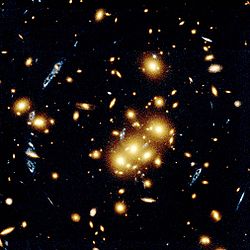
- Astrometry. Study of the position of objects in the sky and their change of position. Defines the coordinate system used and the kinematic of objects in our galaxy.
- Astrophysics. Study of the physics of the universe, including the properties of astronomical objects (luminosity, density, temperature, chemical composition).
- Cosmology. Study of the origin of the universe and its evolution. The study of cosmology is the maximum expression of theoretical astrophysics.
- Formation and evolution of galaxies. Study of the formation of galaxies and their evolution.
- Galactic astronomy. Study of the structure and components of our galaxy and others.
- Extragalactic astronomy. Study of objects outside the Milky Way.
- Star astronomy. Study of stars, their birth, evolution and death.
- Star evolution. Study of the evolution of stars from their formation to their death as a star plunder.
- Star training. Study of the conditions and processes that lead to the formation of stars within gas clouds.
- Planetary sciences. Study of the planets of the Solar System and the extra-solar planets.
- Astrobiology. Study of the appearance and evolution of biological systems in the universe.
Other fields of study
- Archaeomy
- Astrochemistry
- Astrodynamics
- Astronautics
Fields of astronomy by part of the spectrum used
According to the wavelength of the electromagnetic radiation with which the celestial body is observed, astronomy is divided into:
- Optical astronomywhen observation uses only light in wavelengths that can be detected by the human eye, or very close to them (about 400-800 nm). It's the oldest branch.
- Radio astronomy. For observation it uses radiation with wavelengths from mm to cm, similar to that used in broadcasting. Optical and radio astronomy can be done using ground observatories because the atmosphere is transparent in those wavelengths.
- Infrared astronomy. It uses infrared light detectors (longitudes of wave longer than the red one). Infrared light is easily absorbed by water vapor, so infrared observatories must be established in high and dry places.
- High energy astronomy. It includes X-ray astronomy, gamma-ray astronomy and ultraviolet astronomy, as well as the study of neutrinos and cosmic rays. Observations can be made only from aerostatic or spatial observatories.
Appendix IV - Most Relevant Space Exploration Organizations
- NASA
- ESA
- Planetary Society
- SpaceX
Contenido relacionado
Quasar
Equinox
Venus (planet)









